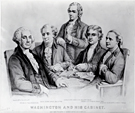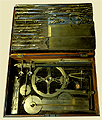 |

7. Books on Table
|
 |


7. BOOKS ON TABLE
Symbolic:
 |
 |

Washington and His Cabinet by Currier and Ives,
lithograph, 1876
National Portrait Gallery,
Smithsonian Institution
|
On the table are two books: Federalist, a reference to the Federalist Papers—essays published to support ratification of the Constitution—and Journal Of Congress. Here, and with the books under the table, Stuart chooses symbols of Washington’s work in the world of ideas and the world of politics, where his integrity and sense of purpose shaped the American presidency.
Biographic:
 |
 |

Alexander Hamilton by John Trumbull,
oil on canvas, 1806
National Portrait Gallery,
Smithsonian Institution
|
The Federalist Papers, which explained and argued in support of the ratification of the U.S. Constitution, first appeared in New York City newspapers in October 1787. The pseudonym “Publius” was used by three men: John Jay, James Madison, and Alexander Hamilton. Washington read all 85 of the papers and ardently gave his support to the proposed Constitution. As President, he also would have read the Journal of Congress, a record of the proceedings of each legislative day in the House of Representatives. The U.S. Constitution requires the House to keep a Journal so that its actions are a matter of public record.
 |
 |

Page from George Washington’s
Book of Civility
Library of Congress
|
Washington was an avid reader from an early age. He was the kind of earnest eighteenth-century youngster who would copy by hand 110 “Rules of Civility and Decent Behaviour in Company and Conversation.” The rules included, “Be not angry at table...Contradict not at every turn what others say...Labour to keep alive in your breast that Little spark of Celestial Fire called Conscience.”
 |
 |

Plan of the battle at White Plains of
1776, annotated
by Washington
Chicago Historical Society
|
Although he was mostly self-taught, Washington was quite literate and especially skilled in mathematics. He was also fascinated by secret codes and spy craft, and utilized spies as part of his military strategy during the Revolutionary War. Outnumbered and sometimes outmaneuvered, Washington often based his tactics on information his spies gathered from the British and their Tory supporters. “There is nothing more necessary than good intelligence to frustrate a designing enemy,” he once wrote.
Artistic:
 |
 |

Gilbert Stuart’s palette
National Portrait Gallery,
Smithsonian Institution
|
Stuart manages to make even the books have color and character. His basic palette included black, burnt umber, Vandyke brown (a transparent organic pigment derived from peat), “lake” (probably “madder lake,” a purple-red pigment, originally obtained from madder root), vermilion, yellow, lead white, Antwerp blue, and burnt sienna.
 |
 |

Gilbert Stuart’s
drawing instruments
National Portrait Gallery,
Smithsonian Institution
|
Architect Samuel Blodget, Jr., son-in-law of William Smith, one of Stuart’s Philadelphia patrons, seems to have helped Stuart select and create the books. Smith’s grandson reported that “Books Papers, Drapery, Table, Chair &c in this Picture . . . were designed and sketched” by Blodget. Whether Blodget mainly helped Stuart compose the painting, or whether he also helped devise some of the symbolism, is unclear.
|




